Abstract
Regolith-hosted rare-earth element (REE) deposits are some of the most important types of REE deposits. The relationship between Late Paleozoic and Early Mesozoic granite and regolith-hosted REE deposits is still poorly studied. Detailed geochronology, geochemistry, and rare-earth mineralogy analyses of Early Triassic granite in the South China Block were conducted. The geochronological results showed that four representative granite samples yielded formation ages of 245 ± 1 Ma, 244 ± 1 Ma, 244 ± 1 Ma, and 244 ± 2 Ma, respectively. The granites show geochemical affinity to A-type granite. They are characterized by enrichment in Rb, Th, and U, are depleted in Ba, Sr, P, and Ti, and show obvious negative Nb and Ta anomalies. They have high light rare-earth element (LREE) and low heavy rare-earth element (HREE) contents, with obvious negative Eu anomalies. They were derived from the partial melting of a sediment source and underwent intense fractional crystallization during the magma evolution process. They contain a certain number of rare-earth-element-bearing minerals, such as monazite, xenotime, apatite, and zircon. Their REE compositions and mineral associations are similar to those of the parent rocks from typical regolith-hosted REE deposits in South China. The highly weathered horizon at the ridge of the granite weathering crust profile has the highest REE content. A comprehensive analysis indicated that the degree of magma evolution, geomorphology, and weathering are important factors controlling the formation of regolith-hosted REE deposits in the area.
1. Introduction
The Tethys Ocean, which was named by Suess (1893) [1], was a trans-equatorial ocean between Eurasia, Africa, and India. Many studies have shown that the Tethys Ocean existed at different geological times and had different evolutionary processes [2]. Metcalfe (2021) divides the Tethys Ocean into the Late Silurian Prototethys, Devonian–Late Triassic Paleotethys, Middle Permian–Late Cretaceous Mesotethys, and Jurassic–Cretaceous Neotethys [3]. The Paleotethys was a Paleozoic ocean between the continents of Gondwana and Laurasia [4,5,6,7]. This has been well documented in Southeast Asia [8,9,10,11,12,13,14]. Previous studies have shown that the framework of the Eastern Paleotethys is complex. The main ocean basin is represented by the Changning–Menglian suture zone, which extends to Thailand [15,16]. The branches of the ocean basin are represented by a series of suture zones, such as the Jinshajiang, Ailaoshan, Songma, and Hainan suture zones [17,18]. In addition, the Tethyan metallogenic domain is a world-famous metallogenic domain that includes different types of deposits, such as skarn Fe deposits, porphyry Cu–Mo–Au, sediment-hosted Pb–Zn deposits, granite-related Sn–W deposits, and so on [19]. In South China, there are numerous granite outcrops along the Tethyan tectonic domain. However, the relationship between the Late Paleozoic and Early Mesozoic granite and regolith-hosted REE deposits in South China is poorly studied.
The Darongshan–Shiwandashan granite belt, an important Late Paleozoic to Early Mesozoic granite belt in South China, is located at the intersection of the Paleo-Pacific and Paleotethys tectonic domains. A thick granitoid weathering crust that is preserved in the Darongshan–Shiwandashan area and some regolith-hosted REE deposits have been discovered [20,21,22,23,24]. The Darongshan–Shiwandashan granite belt provides an ideal location for revealing the Late Paleozoic to Early Mesozoic tectonic evolution of South China and discussing the relationship between granite and regolith-hosted REE deposits. In this study, petrography, zircon U-Pb geochronology, geochemistry, and REE mineralogical data of granites from the Darongshan–Shiwandashan granite belt are presented. Our aims are to (1) discuss the petrogenesis, source characteristics, and tectonic environment of the granite and (2) reveal the ore-controlling conditions of the regolith-hosted REE deposit.
2. Geological Background
The South China Block is composed of the Yangtze Block in the northwest and the Cathaysia Block in the southeast (Figure 1a). The Darongshan–Shiwandashan granite belt is located at the junction of the South China Block, Indochina Block, and Pacific Plate (Figure 1a). The granite belt has an NE trend and extends from Wuzhou in the northeast to the Beibu Gulf in the southwest, with a length of approximately 400 km and a width of approximately 20–75 km [25]. It is mainly controlled by the Bobai–Cenxi and Lingshan–Tengxian faults and is composed of Darongshan, Pubei, Taima, and Jiuzhou plutons (Figure 1b) [26,27]. Previous studies showed that the Taima pluton formed at 249–236 Ma [28,29,30]. The formation age of the Darongshan pluton is 251–243 Ma [31,32]. The Pubei pluton formed at 252–244 Ma [33,34]. Granites from the Jiuzhou pluton have LA-ICP-MS zircon U-Pb ages of 248–245 Ma [26]. Granites from the above plutons generally display obvious negative Nb-Ta anomalies, high Rb, Th, and U contents, low Ba and Sr contents, high Zr/Nb and Ba/Nb ratios, and low Th/Nb and Ta/La ratios [26,28,31,33]. In addition, a few volcanic rocks, such as 247–245 Ma dacite porphyry and ~246 Ma basalt, were reported in the Banba and Hengxian areas [35,36,37].
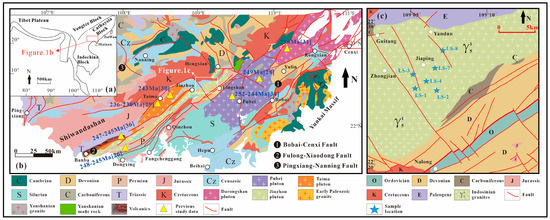
Figure 1.
(a) Simplified tectonic map showing major tectonic units in Southeast Asia (modified after [38]). (b) Simplified geological map showing major plutons of Darongshan–Shiwandashan granite belt (modified after [26]). (c) Sketch of a geological map showing sampling locations.
The wall rocks of the Darongshan–Shiwandashan granite are mainly Silurian, Devonian, Permian, Triassic, and Jurassic sedimentary and volcanic rocks (Figure 1c). The Silurian rocks are mainly composed of a set of shales. The Devonian rocks are composed of mudstone, sandstone, and siltstone and are in interdigitated or gradational contact with the Silurian. The Upper Permian is mainly composed of limestone and clastic limestone with a small amount of siliceous limestone. The Lower Permian strata are composed of carbonate, volcanic breccia, and mafic lava. The Lower Triassic rocks are mainly a set of sedimentary shallow marine carbonates and clastic rocks. The Middle Triassic rocks mainly consist of terrigenous clastic turbidite, and the Upper Triassic rocks are a suite of lithologic clastic rocks and terrigenous red beds. The Jurassic strata are mainly composed of argillaceous siltstone, breccia, and medium- to coarse-grained feldspar quartz sandstone [26].
3. Petrological Characteristics
Four granite samples (LS-3, LS-4, LS-7, and LS-8) from the Darongshan–Shiwandashan granite belt were selected for geochronological analysis (Figure 2). The sampling locations are shown in Figure 1c.
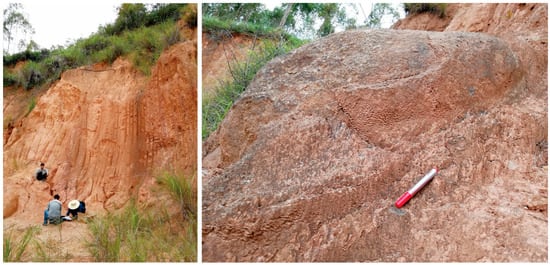
Figure 2.
Field photographs showing the granite weathering crust from Darongshan–Shiwandashan, southeast Guangxi.
Sample LS-3 was biotite granite and was grayish-black with a medium-to coarse-grained texture and massive texture (Figure 3a). The main minerals were quartz, plagioclase, K-feldspar, and biotite (Figure 3b). The quartz (25–35 vol%) was euhedral to anhedral, with sharp contacts. The plagioclase (20–30 vol%) exhibited twinning lamellae. The biotite (10–15 vol%) was a dark-brown, flaky, and had semi-idiomorphic sheets. The K-feldspar (10–15 vol%) was idiomorphic with a grain size of 400–1000 μm.
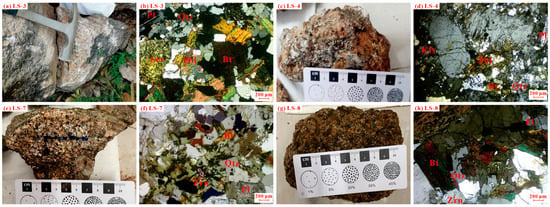
Figure 3.
Field photographs (a,c,e,g) and photomicrographs (b,d,f,h) of granite from Darongshan–Shiwandashan, southeast Guangxi. Bt—biotite; Qtz—quartz; Pl—plagioclase; Kfs—K-feldspar; Phl—phlogopite; Ser—sericite; Zrn—zircon.
Sample LS-4 was biotite granite and was coarse-grained with a massive texture (Figure 3c). The main minerals were quartz, plagioclase, biotite, and K-feldspar (Figure 3d). The biotite (20–30 vol%) was dark brown with a 200–800 μm grain size. The K-feldspar (25–35 vol%) was euhedral to subhedral with a size of 300–1000 μm.
Sample LS-7 was biotite granite and was coarse-grained with a massive texture (Figure 3e). The main minerals were quartz, biotite, and plagioclase. The quartz (30–35 vol%) was irregular with a clean surface. The biotite (10–15 vol%) was dark brown with a size of 200–600 μm. The plagioclase (5–10 vol%) was dark gray with a grain size of 200–500 μm (Figure 3f).
Sample LS-8 was alkaline feldspar granite and was obtained from a spheroidal granite mass. It was grayish-black, and it had a coarse-grained and massive texture (Figure 3g). The main minerals were quartz (25–35 vol%), plagioclase (20–25 vol%), K-feldspar (10–15 vol%), and biotite (10–15 vol%) (Figure 3h).
4. Results
4.1. Zircon U-Pb Dating Results
The LA-ICP-MS zircon U-Pb analysis results are shown in Table 1. CL images show that most of the zircons were brown and idiomorphic, with lengths of 100–350 μm and widths of 90–150 μm (Figure 4). They were characterized by clear oscillating zones, indicating a magmatic source for the texture.

Table 1.
LA-ICP-MS zircon U-Pb isotope results of granite from Darongshan–Shiwandashan, southeast Guangxi.
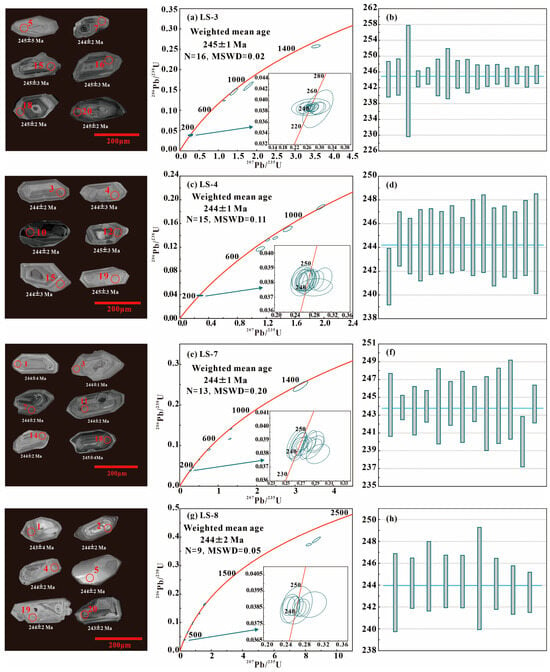
Figure 4.
Cathodoluminescence images of representative zircons and plots of zircon U-Pb concordia and weighted mean age of sample (a,b) LS-3, (c,d) LS-4, (e,f) LS-7, and (g,h) LS-8 from Darongshan–Shiwandashan, southeast Guangxi.
Twenty zircon grains from sample LS-3 were selected for U-Pb isotope testing, and the results showed that the U content was 223–2117 ppm, the Th content was 164–1385 ppm, and the Th/U ratio varied from 0.21 to 1.19 (Table 1). Among them, 16 zircons were located at or near the U-Pb age concordance and gave a weighted average 206Pb/238U age of 245 ± 1 Ma (MSWD = 0.02, 1σ) (Figure 4a,b), representing the crystallization age.
The results of the analysis of 20 zircon grains from sample LS-4 showed that the U content ranged from 216–1583 ppm and the Th content ranged from 86–954 ppm, with the Th/U ratio ranging from 0.07 to 0.77 (Table 1). Fifteen grains yielded a weighted average 206Pb/238U age of 244 ± 1 Ma (MSWD = 0.11, 1σ) (Figure 4c,d), representing the crystallization age.
Twenty zircons from sample LS-7 were selected for U-Pb isotope analysis. The results showed that the U content ranged from 330–1437 ppm, and the Th content ranged from 161–618 ppm, with a Th/U ratio of 0.19 to 1.59 (Table 1). Thirteen zircons yielded a weighted average 206Pb/238U age of 244 ± 1 Ma (MSWD = 0.20, 1σ) (Figure 4e,f), representing the crystallization age.
The results showed that twenty zircon grains from sample LS-8 had a U content of 314–1929 ppm and a Th content of 101–939 ppm, with a Th/U ratio of 0.17–1.31 (Table 1). Nine of the grains yielded a weighted average 206Pb/238U age of 244 ± 2 Ma (MSWD = 0.05, 1σ) (Figure 4g,h), representing the crystallization age.
The trace element composition of zircons in granite showed that they were enriched in Th, U, Ta, Pr, and Hf and relatively depleted in Nb, La, Sr, Nd, and Ti. Additionally, they had high contents of heavy rare-earth elements (HREEs) and low contents of light rare-earth elements (LREEs), accompanied by notable negative Eu anomalies (Figure 5, Table 2 and Table 3).

Figure 5.
Chondrite-normalized REE distribution patterns of zircon from granite from Darongshan–Shiwandashan, southeast Guangxi.

Table 2.
Trace element contents (×10−6) of zircon from granite from Darongshan–Shiwandashan, southeast Guangxi.

Table 3.
REE element contents (×10−6) of zircon from granite from Darongshan–Shiwandashan, southeast Guangxi.
4.2. Geochemical Characteristics
4.2.1. Major Elements
The SiO2 content of the samples was 67.92 wt.%–69.76 wt.% (Table 4). The total alkali (Na2O + K2O) content ranged from 5.59 wt.% to 6.35 wt.%. They were rich in K2O (K2O/Na2O = 0.39–0.63) and belonged to the high-K calc-alkaline series (Figure 6a; [39]). The Al2O3 content was 13.96 wt.%–15.62 wt.%, and the aluminum saturation index (A/CNK) was high (1.17–1.63), as it belonged to peraluminous rock (Figure 6b; [40]). The differentiation index (DI) ranged from 72.8 to 76.4, indicating a high degree of magma differentiation.

Table 4.
Compositions of major (wt.%), trace, and REEs (×10−6) in granite from Darongshan–Shiwandashan, southeast Guangxi.
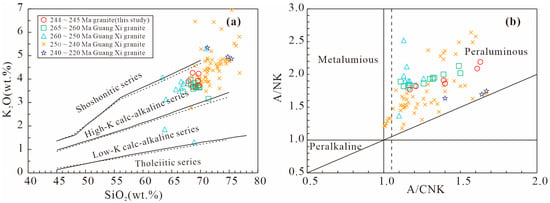
Figure 6.
Plots of (a) K2O versus SiO2 and (b) A/NK versus A/CNK in granite from Darongshan–Shiwandashan, southeast Guangxi. Data source: 265–260 Ma granites: [41]; 260–250 Ma granites: [42]; 250–240 Ma granites: [26,43,44,45]; 240–220 Ma granites: [46].
In the Harker diagrams (Figure 7 and Figure 8), Al2O3, K2O, MgO, TiO2, CaO, Na2O, MnO, P2O5, Ba, Rb, and SiO2 showed negative correlations, indicating that fractional crystallization played a role during magma evolution.
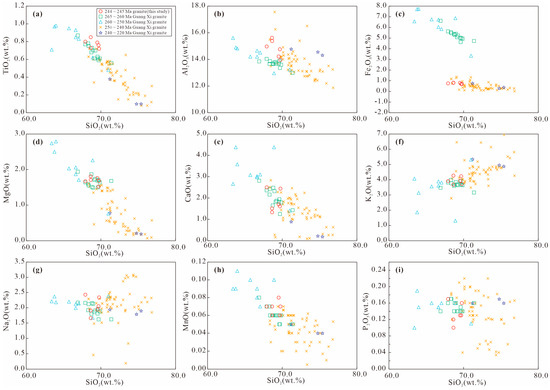
Figure 7.
Plots of (a) TiO2, (b) Al2O3, (c) Fe2O3, (d) MgO, (e) CaO, (f) K2O, (g) Na2O, (h) MnO, and (i) P2O5 versus SiO2 in granite from Darongshan–Shiwandashan, southeast Guangxi. Data sources are the same as in Figure 6.
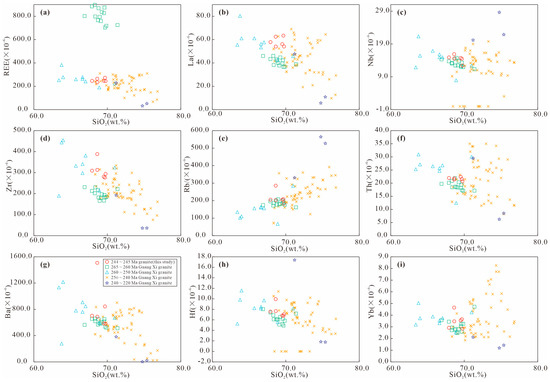
Figure 8.
Plots of (a) REE, (b) La, (c) Nb, (d) Zr, (e) Rb, (f) Th, (g) Ba, (h) Hf, and (i) Yb versus SiO2 in granite from Darongshan–Shiwandashan, southeast Guangxi. Data sources are the same as in Figure 6.
4.2.2. Trace and REE Elements
The granite samples were rich in Rb, Th, and U and depleted in Ba, Nb, Ta, Sr, P, and Ti (Figure 9a). The LREE and HREE contents of the samples were 210.0 × 10−6–245.0 × 10−6 and 23.0 × 10−6–33.0 × 10−6, respectively, indicating that LREEs were relatively enriched. The REE contents were 234.0 × 10−6–273.0 × 10−6, with an average of 252.0 × 10−6, which was much higher than that in the original mantle (7.43 × 10−6). The (La/Sm)N and (Gd/Yb)N ratios are 4.43–4.72 and 1.82–2.31, respectively, with obvious negative Eu anomalies (Eu/Eu* = 0.15–0.18) (Figure 9b).
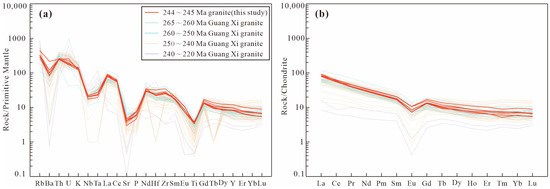
Figure 9.
(a) Chondrite-normalized REE distribution patterns and (b) primitive-mantle-normalized multi-element diagrams of granite from Darongshan–Shiwandashan, southeast Guangxi. Data sources are the same as in Figure 6.
4.2.3. Characteristics of Rare-Earth Minerals
Previous studies have shown that rare-earth elements in granite occur primarily in two types: (1) primary REE-bearing minerals and (2) REE replacements in secondary minerals [47,48]. Scanning electron microscopy (SEM) analyses of the granite samples revealed that the samples primarily contained REE-bearing minerals, such as monazite, xenotime, zircon, and apatite. Zircon and apatite were primarily formed through magma crystallization and occurred in rock-forming minerals, such as biotite (Figure 10). Xenotime was distributed along the edges or fractures of apatite (Figure 10a), indicating that they were mainly formed through hydrothermal alteration. These REE-bearing minerals had relatively high rare-earth element contents and were the main carriers of rare-earth elements in the parent rock, as shown by energy-dispersive spectroscopy (EDS) in Figure 11 and Table 5.
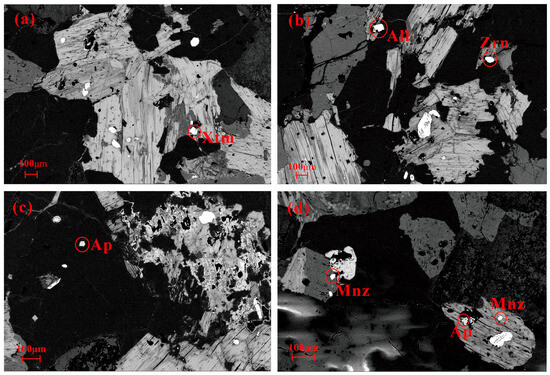
Figure 10.
SEM images (a–d) of granite from Darongshan–Shiwandashan, southeast Guangxi. Xtm—Xenotime; Ap—Apatite; Mnz—Monazite; Zrn—Zircon; All—Allanite.
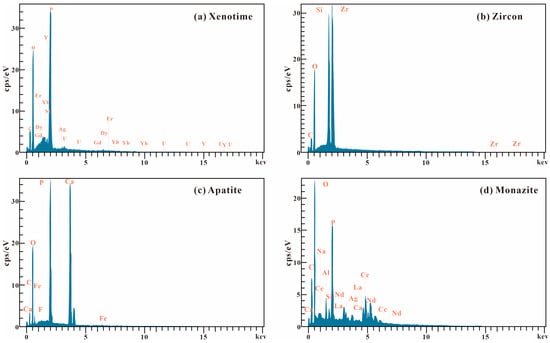
Figure 11.
Spectrogram of energy analysis of (a) xenotime, (b) zircon, (c) apatite, and (d) monazite in granite from Darongshan–Shiwandashan, southeast Guangxi.

Table 5.
Results of energy spectrum analysis of REE-bearing minerals in granite from Darongshan–Shiwandashan, southeast Guangxi.
Xenotime (YPO4) is a phosphate mineral and one of the most important carriers of rare-earth elements. It mainly occurs as granular grains between plagioclase and quartz, with particle sizes ranging from 40 to 100 μm (Figure 10a). Its Y2O3, Gd2O3, and Dy2O3 contents are 47.40 wt.%, 2.53 wt.%, and 4.42 wt.%, respectively (Figure 11a, Table 5).
Zircon (Zr[SiO4]) is a silicate mineral and a common accessory mineral in granite. It primarily occurs as euhedral grains that are interstitial or enclosed in minerals, such as feldspar, biotite, and quartz, with grain sizes ranging from 50 to 100 μm (Figure 10b). It is mainly composed of ZrO2 (69.19 wt.%) and SiO2 (30.81 wt.%) (Figure 11b, Table 5).
Apatite from the granite samples mainly occurred as euhedral or subhedral grains with sizes ranging from 20 to 110 μm (Figure 10c). It is always enclosed by minerals such as quartz and feldspar. Its P2O5, CaO, and FeO contents are 42.69 wt.%, 52.51 wt.%, and 1.05 wt.%, respectively (Figure 11c, Table 5).
5. Discussion
5.1. Rock Type
The genetic type of igneous rock is closely related to geodynamic processes [49]. Research indicates that determining the genesis type of granite is of great significance for studying magma evolution processes and the characteristics of magma source regions. According to its genesis and properties, granite can be classified into the A-, S-, I-, and M-types [50,51,52]. I-, S-, and M-type granite classification mainly emphasizes the difference in the magma source region, while A-type granites mainly reflect the specific geodynamic background. Mineralogy is an important indicator for distinguishing A-, S-, and I-type granites. S-type granite contains peraluminous minerals (such as cordierite). I-type granite most commonly contains hornblende. A-type granite is characterized by alkaline ferromagnesian minerals [50,53]. M-type granite is produced through the differentiation of basic magma and is a mantle-derived granite [50]. In addition, the aluminum saturation index (A/CNK) of I-type granite is less than 1.1, and it is mainly produced by crust–mantle interactions. S-type granite is derived from crust-derived sediments, and its A/CNK ratio is greater than 1.1 [51,52]. A-type granite is formed through magma crystallization at relatively high temperatures and under alkaline, anhydrous, and anorogenic conditions (“3A”), and it is characterized by Zr > 250 × 10−6, (Zr + Ce + Nb + Y) > 350 × 10−6, FeOT/MgO > 16, and 10,000 × Ga/Al > 2.5 [51,52].
Compared with I-type granite, the samples in this study showed high A/CNK ratios (>1.1, Table 4), and there was no hornblende in the photomicrographs, indicating that they were not I-type granite. The P2O5 content was low (0.10–0.17 wt.%; Table 4), and SiO2 was negatively correlated with P2O5 (Figure 7i), indicating that they were different from S-type granite. They showed obvious negative Eu anomalies (Figure 9b), high 10,000 × Ga/Al values (2.16–5.37, average = 3.42), and high (Zr + Nb + Ce + Y) contents (441.69 × 10−6–558.89 × 10−6, average = 471.11 × 10−6). These features are similar to those of A-type granites. In the discriminant diagrams proposed by Whalen (1987), all samples fell into the area of A-type granite [54] (Figure 12a,b). These data indicate that the samples in this study were A-type granite.

Figure 12.
Plots of (a) 10,000 × Ga/Al versus Zr, (b) 10,000 × Ga/Al versus (Zr + Nb + Ce + Y), (c) (Zr + Nb + Ce + Y) versus (Na2O + K2O)/CaO, (d) (Zr + Nb + Ce + Y) versus (FeOT/MgO), (e) Nb-Y-Ce, and (f) Nb-Y-3 × Ga for granite from Darongshan–Shiwandashan, southeast Guangxi. Data sources are the same as in Figure 6.
It is worth noting that highly differentiated I-type, S-type, and A-type granites have similar geochemical characteristic. The P2O5 content of S-type granite is commonly greater than 0.20%, and is positively correlated with the degree of crystallization differentiation [55]. Wang et al. (2000) proposed that FeOT content and formation temperature can distinguish between highly differentiated I-type and A-type granite. The FeOT content of highly differentiated I-type granite is less than 1.00%, and the formation temperature is lower (764 °C) [56]. A-type granite has higher FeOT content (>1.00%) and forms at higher temperatures (>800 °C). Whalen et al. (1987) and Eby (1992) proposed a series of diagrams to further distinguish highly differentiated I-type, S-type, and A-type granites [54,57] (Figure 12c,d).
The P2O5 content of the granite samples is low (0.10%–0.16%), and the FeOT content ranges from 4.63% to 5.39%, which is significantly different from S-type granite (P2O5 > 0.20%) and highly differentiated I-type granite (FeOT < 1.00%). The saturation temperature of zircon determines the formation temperature of granite to be 848–908 °C, with an average temperature of 869 °C (Table 4), which is greater than 764 °C. In the highly differentiated granite type discrimination diagrams (Figure 12c,d), all the samples also fall within the A-type granite area.
A-type granite can be further subdivided into A1- and A2-type granites [57]. The geochemical composition of A1-type granite is consistent with oceanic island basalt (OIB), and it is mainly formed in anorogenic environments, such as intraplate rifting, mantle plumes, or hotspot activities [57]. The geochemical composition of A2-type granite is similar to that of continental crust and island arc basalt, and it is mainly derived from back-arc basins, post-collision areas, or post-orogenic extension environments [57]. The samples in this study were characterized by low Nb and high Y contents that were similar to those of A2-type granite. In the Nb-Y-Ce discrimination diagram, all of the samples fell into the area of A2-type granite (Figure 12e,f). This evidence indicates that the granite samples were A2-type granite.
5.2. Characteristics of the Source Region
According to the geochemical characteristics, the granite samples had high Al2O3 (13.96 wt.%–15.62 wt.%) and alkali (Na2O + K2O = 5.59 wt.%–6.35 wt.%) contents. Their Mg# values were 40–43, lower than that of mantle-derived magma (Mg# > 45). The Nb/Ta (14.49–16.04), Zr/Hf (39.07–41.66), and Rb/Sr (2.09–3.32) ratios were similar to those of continental crust (Nb/Ta = 12, Zr/Hf = 33, Rb/Sr > 0.5). In the δEu versus (La/Yb)N and Ce/Nb versus Y/Nb diagrams, the samples fell within the area of the crust type or average crustal composition (Figure 13a,b). The isotopic data of contemporaneous granites in the study area showed that the granites had enriched Nd isotopic and zircon Hf isotopic compositions (εNd(t) and εHf(t) values of −13.6 to −11.9 and −21.9 to −8.8, respectively, [41]).
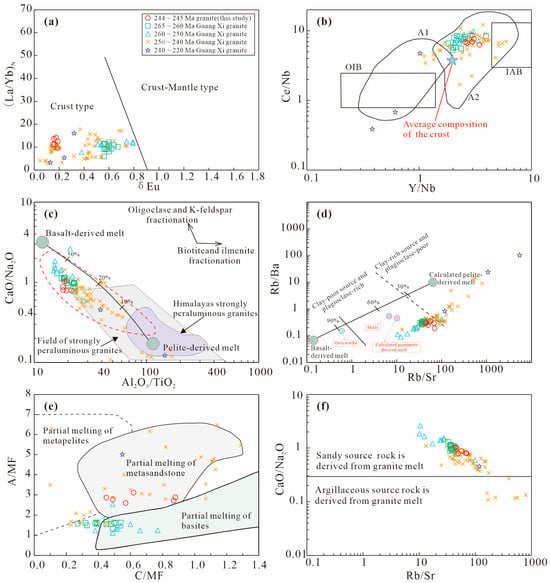
Figure 13.
Plots of (a) δEu versus (La/Yb)N, (b) Y/Nb versus Ce/Nb, (c) Al2O3/TiO2 versus CaO/Na2O, (d) Rb/Sr versus Rb/Ba, (e) C/MF versus A/MF, and (f) Rb/Sr versus CaO/Na2O for granite from Darongshan–Shiwandashan, southeast Guangxi. Data sources are the same as in Figure 6.
All of the above evidence suggests that the samples were mainly derived from crustal material. The geochemical compositions of the samples further indicated that their A/MF, C/MF, and CaO/Na2O ratios were similar to those of metasandstone or sandy source rock (Figure 13e,f). This suggests that the granites originated from partial melting of sandy source rock.
In the Harker diagrams, the contents of Al2O3, K2O, MgO, TiO2, CaO, Na2O, MnO, P2O5, Ba, and Rb showed a negative correlation with SiO2 (Figure 7 and Figure 8). In the La-La/Sm diagram (Figure 14a), the samples showed an obvious trend of fractional crystallization. Additionally, they had a high differentiation index (DI = 72.8–76.4). This evidence indicates that fractional crystallization occurred during magma evolution. In the related diagrams, fractional crystallization of plagioclase and accessory minerals (such as monazite and allanite) can be observed (Figure 14b–d). The depletion of P and Ti (Figure 9a) indicates the crystallization of phosphorus- and titanium-bearing minerals. The negative anomalies of Eu and Sr (Figure 9b) are related to the crystallization of plagioclase (Figure 14b,c).

Figure 14.
Plots of (a) La versus La/Sm, (b) La versus Rb, (c) La versus Ba, and (d) La versus (La/Yb)N for granite from Darongshan–Shiwandashan, southeast Guangxi. Data sources are the same as in Figure 6. Pl—plagioclase; Kfs—K-feldspar; Bt—biotite; Ms—muscovite; Amp—amphibolite; Grtgarnet; Zr—zircon; Sph—sphaerocobaltite; Ap—apatite; Allan—allanite; Monmonazite.
5.3. Tectonic Environment
As discussed above, the formation age of the granite samples in this study was 244–245 Ma, and they were A2-type granite. Previous studies have shown that A-type granite forms in an extensional tectonic environment [57,58]. This indicates that the samples were formed in an extensional environment. In addition, they fell into the area of within-plate granite (WPG) (Figure 15a,b), further indicating that they formed in an extension setting.
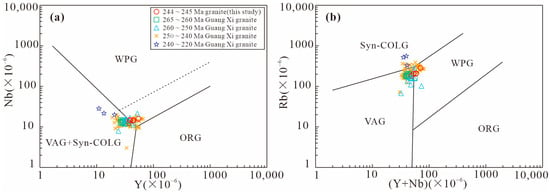
Figure 15.
Plots of (a) Y versus Nb and (b) Y + Nb versus Rb of granite from Darongshan–Shiwandashan, southeast Guangxi. Data sources are the same as in Figure 6.
Extensive magmatism occurred in the South China and Indochina blocks during the Late Paleozoic to Early Mesozoic periods. The Jinshajiang suture zone outcropped 247–246 Ma rhyolite that was formed by a collision event caused by the subduction of the Paleotethys oceanic crust [59]. In addition, 253–247 Ma granite and volcanic rocks were reported in the Ailaoshan suture zone, and their tectonic settings were syn-collision or arc-continent collision [60,61,62]. Roger et al. (2012) and Wang et al. (2014) proposed that the formation of Early Triassic (248 Ma) granite in northern Vietnam (Indochina block) was related to continental collision or arc-continent collision resulting from the subduction of the Paleotethys oceanic crust [63,64].
Granite from the Darongshan–Shiwandashan granite belt is considered to have been formed through the subduction of the Paleotethys oceanic crust [42]. Recent studies have revealed that contemporaneous basalt (250–248 Ma), diabase (247 Ma), and dacite porphyry (247–245 Ma) were preserved in the Darongshan–Shiwandashan area [65,66], and their formation was related to the evolution of Paleotethys [38]. These data indicate that the Late Paleozoic to Early Mesozoic tectonic evolution of the Darongshan–Shiwandashan area was influenced by the evolution of Paleotethys.
Considering the above, it is suggested that records of Paleotethys are well preserved in the South China and Indochina blocks (Figure 16), and the Early Triassic A-type granite in the Darongshan–Shiwandashan area was formed in an extensional tectonic background, which was related to the evolution of Paleotethys.
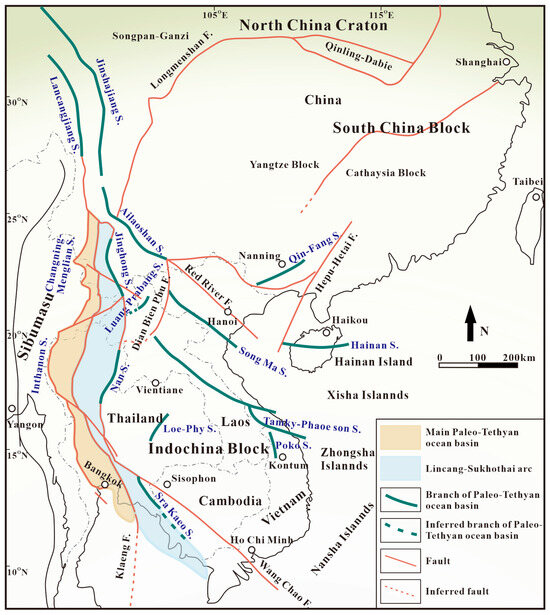
Figure 16.
Spatiotemporal framework of main and branched Paleotethyan ocean basin in SE Asia. Modified from [26].
5.4. Ore-Controlling Factors of Regolith-Hosted REE Deposits
5.4.1. Parent Rock Properties
Previous studies have shown that the formation and scale of regolith-hosted REE deposits are directly related to the content of rare-earth elements in the parent rocks [67,68]. Weathering of parent rocks enriched in light rare-earth elements results in light rare-earth regolith-hosted REE deposits, whereas weathering of those enriched in heavy rare-earth elements forms heavy rare-earth regolith-hosted REE deposits [67,69]. The parent rocks of regolith-hosted light REE deposits are mainly biotite monzonite granite, muscovite granite, granite-porphyry, two mica granite, syenite, tuff, and rhyolite, which contain accessory minerals enriched in light rare-earth elements such as bastnaesite, monazite, apatite, titanite, and allanite. The parent rocks of regolith-hosted heavy REE deposits are mostly medium-fine-grained two-mica granite and muscovite granite, which contain accessory minerals enriched in heavy rare-earth elements such as fergusonite, gadolinite, xenotime, euxenite, polycrase, thorite, and zircon [67,70].
The granite samples in this study contain REE-bearing minerals such as xenotime, monazite, apatite, and zircon that are enriched in rare-earth elements. The energy spectrum results show that the content of rare-earth oxides in monazite and xenotime is relatively high (Table 4). The total amount of rare-earth elements (234.0 × 10−6–273.0 × 10−6) in the granite samples was much higher than the lower limit values of the parent rock (132.0 × 10−6) [71]. In addition, the ratios and contents of rare-earth elements, together with the rare-earth mineral associations of the samples, are similar to those in the ore-forming parent rocks in Jiangxi and Yunnan (Table 6; Figure 17). This evidence indicates that the granites in this area show a good material basis for forming regolith-hosted REE deposits.
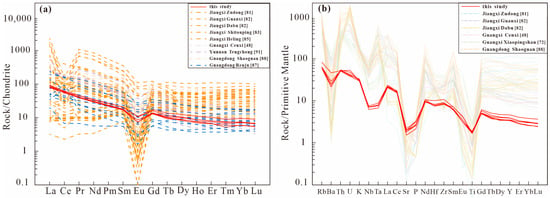
Figure 17.
(a) Chondrite-normalized REE distribution patterns and (b) primitive-mantle-normalized multi-element diagrams of parent rocks of some typical regolith-hosted REE deposits in South China.
The distribution of regolith-hosted REE deposits/mineralization in the Darongshan–Shiwandashan area is closely related to the lithology. Outcrops of biotite granite, muscovite granite, and two-mica granite show higher total rare-earth element (REE) content (206 × 10−6–343 × 10−6, this study; [71]), and regolith-hosted REE deposits/mineralization are also distributed in the above lithologic areas. In contrast, the Yong’an pluton, a part of the Darongshan–Shiwandashan granite belt, is mainly composed of granodiorite, and its REE content is 175 × 10−6–241 × 10−6 [45], which is obviously different from the above lithologic areas. At present, no regolith-hosted REE deposits have been found in the Yong’an area. One of the main reasons for this is that the Yong’an pluton underwent relatively weak magma evolution.
Previous studies have shown that strong fractional crystallization favors the crystallization of REE-bearing minerals such as zircon, sphene, apatite, monazite, and xenotime, which are easily decomposed and adsorbed during later weathering processes, thus providing a material basis for the enrichment of rare-earth elements [72,73,74]. Studies have further pointed out that the fractionation and leaching of rare-earth elements in the parent rock must have a high degree of magma evolution [75,76,77]. The granite in this study underwent fractional crystallization (Figure 7, Figure 8 and Figure 14). Therefore, strong fractional crystallization of parent rocks may be favorable for the formation of regolith-hosted REE deposits.

Table 6.
Comparison of parent rocks of typical regolith-hosted REE deposits in South China.
Table 6.
Comparison of parent rocks of typical regolith-hosted REE deposits in South China.
| Name of Deposit | Parent Rock/Age | Rare-Earth Minerals | ΣREE (×10−6) | ΣLREE (×10−6) | ΣHREE (×10−6) | ΣLREE /ΣHREE | Reference |
|---|---|---|---|---|---|---|---|
| Guangxi Qinfang | granite | Apatite, zircon, xenotime, monazite | 252 | 225 | 27 | 8.58 | this study |
| Jiangxi Dafuzu | granite (226 Ma) | Apatite, xenotime | 328–414 | 199–242 | 82–107 | 1.2–2.4 | [78] |
| Jiangxi Wulitin | Biotite monzonitic granite (238 Ma) | Apatite, allanite | 354–453 | 305–407 | 46–48 | 6.3–8.9 | [79] |
| Jiangxi Shangyou | Medium coarse-grained porphyritic biotite granite | Zircon, xenotime | 148 | 61 | 87 | 0.63 | [80] |
| Jiangxi Zudong | Biotite potassium feldspar granite | Xenotime, monazite | 261 | 75 | 187 | 0.51 | [81] |
| Jiangxi Guanxi | Alkaline feldspar granite (190 Ma) | Xenotime, monazite | 469 | 419 | 50 | 8.38 | [82] |
| Jiangxi Dabu | Muscovite granite (155 Ma) | Xenotime, monazite | 125 | 55 | 70 | 0.79 | [82] |
| Jiangxi Shitouping | granite | Xenotime, monazite, bastnaesite | 685 | 351 | 334 | 1.2 | [83] |
| Jiangxi Qingxi | Biotite granite (230 Ma) | Xenotime | 398 | 356 | 42 | 8.5 | [84] |
| Jiangxi Heling | Granite porphyry | Apatite, zircon, bastnaesite | 808 | 724 | 84 | 8.6 | [85] |
| Guangdong Renju | Granodiorite | Xenotime, zircon | 338 | 287 | 51 | 5.61 | [86] |
| Guangdong Renju | Quartz diorite | Apatite, zircon, sphene, bastnaesite | 298 | 267 | 31 | 9.44 | [87] |
| Guangdong Shaoguan | Biotite granite (162 Ma) | Xenotime | 297 | 205 | 20 | 6.7 | [88] |
| Guangxi Huashan | Biotite granite | Sphene | 323 | 245 | 78 | 3.12 | [89] |
| Guangxi Cenxi | Granite (155 Ma) | Apatite, zircon, monazite, bastnaesite | 279 | 199 | 79 | 2.55 | [48] |
| Guangxi Dazhou | Biotite granite | Allanite | 299 | 217 | 82 | 2.65 | [90] |
| Guangxi Xiaopingshan | Biotite monzonitic granite | Apatite, zircon, monazite | 343 | 228 | 114 | 2 | [72] |
| Yunnan Tengchong | granite | Xenotime, zircon | 783 | 87 | 12 | 7.9 | [91] |
| Yunnan Chahe | Biotite monzonitic granite | Xenotime | 257 | 202 | 55 | 3.67 | [92] |
| Yunnan Lincang | Biotite monzonitic granite | Xenotime | 361 | 300 | 64 | 5.55 | [93] |
5.4.2. Geomorphology
The geomorphology of the study area mainly consists of mountains and hills. The rare-earth element contents from two weathering crust profiles showed that the top, upper, middle, and lower parts had REE contents of 329 × 10−6 and 178 × 10−6, 369 × 10−6–929 × 10−6 and 155 × 10−6–226 × 10−6, 402 × 10−6–436 × 10−6 and 184 × 10−6–224 × 10−6, and 343 × 10−6 and 131 × 10−6, respectively (Figure 18, Table 7). This indicates that different parts of the weathering crust profile show different rare-earth element contents. More specifically, the middle and upper parts showed the highest REE contents, whereas the top and lower parts were characterized by lower REE contents. This indicates that geomorphology is an important ore-controlling factor of the regolith-hosted REE deposits in the area, and the ridge area in the middle and upper parts is a favorable position for the enrichment of rare-earth elements. In contrast, the steep terrain lacks good conditions for the storage of rare-earth elements, and thus, it is difficult for deposits to be formed.
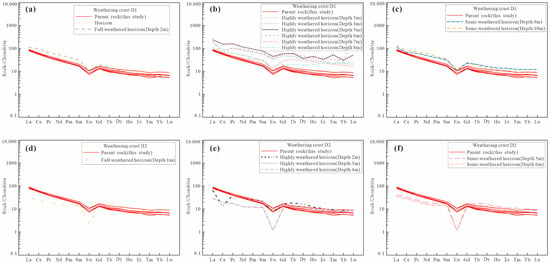
Figure 18.
Chondrite-normalized REE distribution patterns of parent rocks and (a,d) full weathered horizon, (b,e) highly weathered horizon, and (c,f) semi-weathered horizon of weathering crust D1 and D2. Comparison data are sourced from [72].

Table 7.
REE compositions of granite and weathering crust from Darongshan–Shiwandashan, southeast Guangxi.
5.4.3. Weathering
The development, integrity, and thickness of the weathering crust are all affected by the intensity of weathering [94]. Typical weathering crust profiles, from top to bottom, can be divided into a fully weathered horizon, highly weathered horizon, semi-weathered horizon, weakly weathered horizon, and parent rock. The rare-earth element contents in the fully weathered horizon, highly weathered horizon, and semi-weathered horizon of the two weathering profiles are 329 × 10−6–423 × 10−6, 369 × 10−6–929 × 10−6, and 402 × 10−6–436 × 10−6 and 178 × 10−6, 155 × 10−6–226 × 10−6, and 184 × 10−6–224 × 10−6, respectively (Figure 18, Table 7). It can be seen that the maximum REE content in both profiles occurs in the highly weathered horizon. Theoretically, a higher degree of weathering is more conducive to the precipitation of rare-earth elements [95]. However, the maximum REE content did not occur in the fully weathered horizon, indicating that the degree of weathering is not directly proportional to the enrichment of REE. In addition, the fully weathered horizon in the study area is located at the top of the hillside, with a steep terrain and large slope, which is not conducive to the storage of rare-earth elements. In contrast, the highly weathered horizon is located at a relatively wide and slow terrain and undergoes strong vertical and lateral leaching, thus having the highest rare-earth element content.
The LREE/HREE ratio of the two weathering crust profiles gradually decreased from the fully weathered horizon to the semi-weathered horizon (Table 6; Figure 18), indicating that there is a differentiation of light and heavy rare-earth elements from the upper to lower parts of the weathering crust. The differentiation of light and heavy rare-earth elements may be related to the stability of rare-earth complexes and ligand complexation in soil solutions [96,97]. For instance, surface water contains anions such as carbon and phosphate ions. The complexation between these anions and heavy rare-earth elements leads to stronger mobility of heavy rare-earth elements, thus resulting in the accumulation of heavy rare-earth elements at the lower part of the weathering profile. Furthermore, prolonged and intense weathering and leaching facilitate the differentiation of light and heavy rare-earth elements, resulting in the accumulation of heavy rare-earth elements in the lower section of the weathering crust.
It is worth noting that the formation of regolith-hosted REE deposits is complex and results from the mutual influence and interaction of multiple factors. For example, geomorphology affects the migration and storage of rare-earth elements and the infiltration and leaching of surface water. This further affects the enrichment of rare-earth elements in the vertical section of the weathering crust profile. Moreover, it is difficult for mineralization to occur with a single factor; for example, the Darongshan and Yong’an plutons, both belonging to the Darongshan–Shiwandashan granite belt, have similar geomorphologies and climate conditions. However, only the former exhibits good regolith-hosted REE mineralization. The possible reasons are as follows: (1) The lithology and the degree of magma evolution are different. The Yong’an pluton is dominated by granodiorite and shows a low degree of magma evolution; (2) the degree of weathering is different. The weathered horizon of the Yong’an pluton is thin. Spherically weathered residual bodies are common, and even some fresh rock outcrops can be observed. In addition to the ore-controlling factors mentioned above, climate, hydrodynamic conditions, PH value, hydrothermal metamorphism, and microbial interactions are all influencing factors of regolith-hosted REE deposits [98,99]. These factors should be comprehensively considered in studies on the formation and differentiation mechanisms of regolith-hosted REE deposits.
6. Conclusions
(1) Geochemical data indicate that some Early Triassic (244–245 Ma) granite in the Darongshan–Shiwandashan granite belt belongs to A-type granite.
(2) The granite belongs to high-potassium calc-alkaline rock and is the product of the partial melting of sandy source rocks. Fractional crystallization of plagioclase, apatite, monazite, and epidote occurred during magma evolution. This formed in an extension tectonic background, which was related to the evolution of the Paleotethys.
(3) The granite is enriched in light rare-earth elements (LREE) and depleted in heavy rare-earth elements (HREE), and it contains certain REE-bearing minerals, such as xenotime, monazite, apatite, and zircon. These characteristics are comparable with those of the parent rocks of typical regolith-hosted REE deposits in South China. The highly weathered horizon located at the mountain ridge showed the highest concentration of rare-earth elements. The formation of regolith-hosted REE deposits in the Darongshan–Shiwandashan areas is primarily controlled by the degree of magma evolution, geomorphology, and weathering processes.
Supplementary Materials
Analytical methods can be downloaded at: https://www.mdpi.com/article/10.3390/min15050530/s1.
Author Contributions
Conceptualization, L.Y. and Y.C. (Yongfeng Cai); methodology, J.O. and F.X.; software, L.Y.; validation, Y.C. (Yongfeng Cai); formal analysis, J.O. and F.X.; investigation, L.Y., Y.C. (Yongfeng Cai), Y.C. (Yankun Chen) and F.X.; resources, Y.C. (Yongfeng Cai); data curation, L.Y.; writing—original draft preparation, L.Y.; writing—review and editing, L.Y., Y.Z. and Y.C. (Yongfeng Cai); supervision, Y.C. (Yongfeng Cai); project administration, Y.C. (Yongfeng Cai); funding acquisition, Y.C. (Yongfeng Cai) All authors have read and agreed to the published version of the manuscript.
Funding
This work was supported by the National Natural Science Foundation of China (Grant No. 42372102) and the Guangxi Key R&D Program (Grant No. Guike AB22035045).
Data Availability Statement
The original contributions presented in this study are included in the article/Supplementary Materials. Further inquiries can be directed to the corresponding author.
Acknowledgments
We appreciate the editor and reviewers for their valuable suggestions and constructive comments on this paper.
Conflicts of Interest
The authors declare no conflicts of interest. The funders had no role in the design of the study, in the collection, analyses, or interpretation of data, in the writing of the manuscript, or in the decision to publish the results.
References
- Suess, E. Are great ocean depths permanent. Nat. Sci. 1893, 2, 180–187. [Google Scholar]
- Metcalfe, I. Gondwana Dispersion and Asian Accretion: An Overview. J. Afr. Earth Sci. 1999, 29, 8–28. [Google Scholar]
- Metcalfe, I. Multiple Tethyan Ocean Basins and Orogenic Belts in Asia. Gondwana Res. 2021, 100, 87–130. [Google Scholar] [CrossRef]
- Wang, Y.J.; Qian, X.; Cawood, P.A.; Liu, H.C.; Feng, Q.L.; Zhao, G.C.; Zhang, Y.H.; He, H.Y.; Zhang, P.Z. Closure of the East Paleotethyan Ocean and Amalgamation of the Eastern Cimmerian and Southeast Asia Continental Fragments. Earth-Sci. Rev. 2018, 186, 195–230. [Google Scholar] [CrossRef]
- Stampfli, G.M. Tethyan oceans. Geol. Soc. Lond. Spec. Publ. 2000, 173, 1–23. [Google Scholar] [CrossRef]
- Zhu, D.C.; Mo, X.X.; Zhao, Z.D.; Niu, Y.L.; Wang, L.Q.; Chu, Q.H.; Gui, T.P.; Xu, J.F.; Zhou, C.Y. Presence of Permian extension-and arc-type magmatism in southern Tibet: Paleogeographic implications. Bulletin 2010, 122, 979–993. [Google Scholar] [CrossRef]
- Yang, J.; Du, Y.S.; Huang, H.; Yang, J.H.; Huang, H.W.; Huang, Z.Q. Devonian–Carboniferous Pillow OIB-Type Basalts in the Youjiang Basin, SW China: Implications for the Eastern Extension of the Paleo-Tethys Branch Ocean. J. Earth Sci. 2023, 34, 690–705. [Google Scholar] [CrossRef]
- Liu, F.; Lin, W.; Wang, Y.; Meng, L.T.; Faure, M.; Nguyen, V.V.; Wu, Q.Y.; Chu, Y.; Wei, W.; Thu, H.L.T.; et al. Heterogeneity of the Ailaoshan–Song Ma ophiolitic mélange and its palaeogeographic implications for the evolution of Eastern Palaeo-Tethys. Tectonophysics 2023, 858, 229848. [Google Scholar] [CrossRef]
- Qian, X.; Wang, Y.J.; Zhang, Y.Z.; Zhang, Y.H.; Vongpaseuth, S.; Zhang, A.M.; He, H.Y. Petrogenesis of Permian–Triassic Felsic Igneous Rocks along the Truong Son Zone in Northern Laos and Their Paleotethyan Assembly. Lithos 2019, 328, 101–114. [Google Scholar] [CrossRef]
- Shi, M.F.; Wu, Z.B.; Liu, S.S.; Peng, Z.M.; Guo, L.N.; Nie, F.; Xu, S.W. Geochronology and Petrochemistry of Volcanic Rocks in the Xaignabouli Area, NW Laos. J. Earth Sci. 2019, 30, 37–51. [Google Scholar] [CrossRef]
- Yang, L.; Yuan, W.M.; Zhu, X.Y.; Shi, Z. Late Triassic-Cenozoic Thermochronology in the Southern Sanjiang Tethys, SW China: New Insights from Zircon Fission Track Analysis. J. Earth Sci. 2019, 30, 996–1004. [Google Scholar] [CrossRef]
- Zhai, Q.G.; Chung, S.L.; Tang, Y.; Hu, P.Y.; Jin, X.C.; Wang, J.; Wang, H.T.; Wang, K.L.; Lee, H.Y. Late Carboniferous Ophiolites from the Southern Lancangjiang Belt, SW China: Implication for the Arc–Back-Arc System in the Eastern Paleo-Tethys. Lithos 2019, 344, 134–146. [Google Scholar] [CrossRef]
- Sone, M.; Metcalfe, I. Parallel Tethyan Sutures in Mainland Southeast Asia: New Insights for Palaeo-Tethys Closure and Implications for the Indosinian Orogeny. Comptes Rendus Geosci. 2008, 340, 166–179. [Google Scholar] [CrossRef]
- Yu, Y.Q.; Qian, X.; Ghani, A.A.; Zhang, Y.Z.; Wang, Y.J. Triassic Felsic Magmatism in SE Peninsular Malaysia: Petrogenesis and Geodynamic Implications for the Eastern Paleotethyan Tectonic Transition. Lithos 2023, 462, 107399. [Google Scholar] [CrossRef]
- Wang, Y.J.; He, H.Y.; Cawood, P.A.; Srithai, B.; Feng, Q.L.; Fan, W.M.; Zhang, Y.Z.; Qian, X. Geochronological, Elemental and Sr-Nd-Hf-O Isotopic Constraints on the Petrogenesis of the Triassic Post-Collisional Granitic Rocks in NW Thailand and Its Paleotethyan Implications. Lithos 2016, 266, 264–286. [Google Scholar] [CrossRef]
- Wang, H.N.; Liu, F.L.; Santosh, M.; Wang, F. Subduction Erosion Associated with Paleo-Tethys Closure: Deep Subduction of Sediments and High Pressure Metamorphism in the SE Tibetan Plateau. Gondwana Res. 2020, 82, 171–192. [Google Scholar] [CrossRef]
- Wang, H.N.; Liu, F.L.; Santosh, M.; Cai, J.; Wang, F.; Ji, L. Rapid Cold Slab Subduction of the Paleo-Tethys: Insights from Lawsonite-Bearing Blueschist in the Changning–Menglian Orogenic Belt, Southeastern Tibetan Plateau. Gondwana Res. 2020, 85, 189–223. [Google Scholar] [CrossRef]
- Huang, H.; Jin, X.C.; Shi, Y.K.; Zhen, J.B.; Yan, Z. New Fusulinid Assemblages from the Changning-Menglian Belt in Western Yunnan, China and Their Paleogeographic Implications. J. Asian Earth Sci. 2023, 256, 105807. [Google Scholar] [CrossRef]
- Hou, Z.Q.; Zhang, H.R. Geodynamics and metallogeny of the eastern Tethyan metallogenic domain. Ore Geol. Rev. 2015, 70, 346–384. [Google Scholar] [CrossRef]
- Fu, X.N.; Yi, Z.B.; Fu, W.; Liu, J.C.; Han, Z.X.; Fang, G.C.; Sha, X.; Liu, X.; Xu, C. Mineralogy and weathering of REE minerals in the Liuchen granite, Guangxi, southern China: Implications for HREE enrichment in the granite regolith. Ore Geol. Rev. 2024, 169, 106099. [Google Scholar] [CrossRef]
- Fu, X.N.; Bai, Y.P.; Fu, W.; Zhao, Q.; Li, P.Q.; Guo, X.H.; Tang, Z.H. Comparison of weathering enrichment effects of rare earth elements in the Liuchen and Darongshan granites in Southeastern Guangxi and their provenance study. J. Guilin Univ. Technol. 2025, 45, 1–15, (In Chinese with English Abstract). [Google Scholar]
- Fu, W.; Dong, C.F.; Xu, C.; Wang, R.H.; Lu, J.P.; Zhou, H.; Han, Z.X.; Yi, Z.B.; Lv, Y.Z.; Huang, G.Q.; et al. Research on Prospecting Direction of Ion-Adsorption Type Heavy Rare Earth Element Resources in Guangxi and Progresses in Scientific Demonstration Exploration. Earth Sci. 2024, 49, 1931–1945, (In Chinese with English Abstract). [Google Scholar]
- Zhao, Z.; Wang, D.H.; Pan, H.; Qu, W.J. REE Geochemistry of a Weathering Profile in Guangxi, Southern China, and Genesis of Ion-Adsorption Type REE Deposit. Earth Sci. 2017, 42, 1697–1706, (In Chinese with English Abstract). [Google Scholar]
- Fu, W.; Luo, P.; Hu, Z.Y.; Feng, Y.Y.; Liu, L.; Yang, J.B.; Feng, M.; Yu, H.X.; Zhou, Y.Z. Enrichment of ion-exchangeable rare earth elements by felsic volcanic rock weathering in South China: Genetic mechanism and formation preference. Ore Geol. Rev. 2019, 114, 103120. [Google Scholar] [CrossRef]
- Tian, M.Y. Petrological Assemblage and Geological Implications of the Indosinian Igneous Rocks in Southeastern Guangxi Province. Master’s Thesis, China University of Geosciences, Beijing, China, 2021; pp. 1–67. [Google Scholar]
- Zhou, Y.; Zhao, Y.S.; Cai, Y.F.; Hu, Q.F.; Wang, C. Permian-Triassic Magmatism in the Qin-Fang Tectonic Belt, SW China: New Insights into Tectonic Evolution of the Eastern Paleo-Tethys. J. Earth Sci. 2023, 34, 1704–1716. [Google Scholar] [CrossRef]
- Zhao, L.; Guo, F.; Fan, W.M.; Li, C.W.; Qin, X.F.; Li, H.X. Crustal Evolution of the Shiwandashan Area in South China: Zircon U-Pb-Hf Isotopic Records from Granulite Enclaves in Indo-Sinian Granites. Chin. Sci. Bull. 2010, 55, 2028–2038, (In Chinese with English Abstract). [Google Scholar] [CrossRef]
- Jiao, S.J.; Li, X.H.; Huang, H.Q.; Deng, X.G. Metasedimentary Melting in the Formation of Charnockite: Petrological and Zircon U-Pb-Hf-O Isotope Evidence from the Darongshan S-Type Granitic Complex in Southern China. Lithos 2015, 239, 217–233. [Google Scholar] [CrossRef]
- Deng, X.G.; Chen, Z.G.; Li, X.H.; Liu, D.Y. SHRIMP U-Pb zircon dating of the Darongshan-Shiwandashan granitoid belt in southeastern Guangxi, China. Geol. Rev. 2004, 50, 426–432, (In Chinese with English Abstract). [Google Scholar]
- Wang, W.B.; Li, J.H.; Xin, Y.J.; Sun, H.S.; Yu, Y.Q. Zircon LA-ICP-MS U-Pb dating and geochemical analysis of the Darongshan-Shiwandashan granitoids in southwestern South China and their geological implications. Acta Geosci. Sin. 2018, 39, 179–188, (In Chinese with English Abstract). [Google Scholar]
- Chen, C.H.; Hsieh, P.S.; Lee, C.Y.; Zhou, H.W. Two Episodes of the Indosinian Thermal Event on the South China Block: Constraints from LA-ICPMS U-Pb Zircon and Electron Microprobe Monazite Ages of the Darongshan S-Type Granitic Suite. Gondwana Res. 2011, 19, 1008–1023. [Google Scholar] [CrossRef]
- Li, J.H.; Zhao, G.C.; Johnston, S.T.; Dong, S.W.; Zhang, Y.Q.; Xin, Y.J.; Wang, W.B.; Sun, H.S.; Yu, Y.Q. Permo-Triassic structural evolution of the Shiwandashan and Youjiang structural belts, South China. J. Struct. Geol. 2017, 100, 24–44. [Google Scholar] [CrossRef]
- Huang, C.; Shen, R.W.; Nan, Z.L.; Fu, L.G.; Liu, S.; Cai, D.Z.; Wang, H.; Yu, Y.Z. Zircon U-Pb Ages and Geochemical Characteristics of Early Indosinian Liuwanshan Granites, Guangxi. Geol. Bull. China 2017, 36, 209–223, (In Chinese with English Abstract). [Google Scholar]
- Wang, M.F.; Zhang, X.B.; Pi, D.H.; Guo, X.N. Zircon U–Pb dating of Pubei granite and strontium isotope from sphalerite of the Xinhua Pb–Zn–(Ag) deposit, Yunkai area of Guangxi Province, South China. Acta Geochim. 2016, 35, 156–171. [Google Scholar] [CrossRef]
- Qin, X.F.; Wang, Z.Q.; Cao, J.; Feng, Z.H.; Hu, G.A.; Pan, L.Z. Petrogenesis of early Indosinian granites from the southwestern segment of Qinfang tectonic belt, southern Guangxi: Constraints from zircon U-Pb chronology and geochemistry. J. Jilin Univ. (Earth Sci. Ed.) 2013, 43, 1471–1487, (In Chinese with English Abstract). [Google Scholar]
- Qin, Y.; Cai, Y.F.; Liu, J.; Liu, X.J.; Zhou, Y.; Li, Z.L.; Yang, L.Y. Magmatism Records of Palaeo-Tethyan Evolution: Evidence from Indosinian Volcanic Rocks in Southeastern Guangxi. Earth Sci. 2024, 49, 3140–3154, (In Chinese with English Abstract). [Google Scholar]
- Liu, D.; Kang, Z.Q.; Xu, J.F.; Chen, L.G.; Wei, N.S.; Wei, T.W.; Li, D.X.; Chen, H.; Cao, Y.; Liu, D.M.; et al. Chronology, geochemistry and genetic significance of Mashan basalt in southeast Guangxi. J. Guilin Univ. Technol. 2019, 39, 806–816, (In Chinese with English Abstract). [Google Scholar]
- Qin, Y.; Zhou, Y.; Liu, X.J.; Zhao, Y.S.; Li, Z.L.; Yang, L.Y.; Li, C.; Cai, Y.F. Geochronology and Geochemistry of Igneous Rocks in the Qinfang Belt: Implications for Spatio-Temporal Framework of Paleo-Tethys. Lithos 2025, 494–495, 107900. [Google Scholar] [CrossRef]
- Peccerillo, A.; Taylor, S.R. Geochemistry of Eocene Calc-Alkaline Volcanic Rocks from the Kastamonu Area, Northern Turkey. Contrib. Mineral. Petrol. 1976, 58, 63–81. [Google Scholar] [CrossRef]
- Maniar, P.D.; Piccoli, P.M. Tectonic Discrimination of Granitoids. Geol. Soc. Am. Bull. 1989, 101, 635–643. [Google Scholar] [CrossRef]
- Li, Y.J.; Wei, J.H.; Santosh, M.; Tan, J.; Fu, L.B.; Zhao, S.Q. Geochronology and Petrogenesis of Middle Permian S-Type Granitoid in Southeastern Guangxi Province, South China: Implications for Closure of the Eastern Paleo-Tethys. Tectonophysics 2016, 682, 1–16. [Google Scholar] [CrossRef]
- Zhao, L.; Guo, F.; Fan, W.M.; Li, C.W.; Qin, X.F.; Li, H.X. Origin of the Granulite Enclaves in Indo-Sinian Peraluminous Granites, South China and Its Implication for Crustal Anatexis. Lithos 2012, 150, 209–226. [Google Scholar] [CrossRef]
- Charoy, B.; Barbey, P. Ferromagnesian Silicate Association in S-Type Granites: The Darongshan Granitic Complex (Guangxi, South China). Bull. Société Géologique France 2008, 179, 13–27. [Google Scholar] [CrossRef]
- Fang, D.Y. Geological, Geochemical Characteristics and Petrogenesis of the Wangchong Granitic Super Unit, Darongshan Area, Guangxi Province. Master’s Thesis, East China University of Technology, Nanchang, China, 2012. [Google Scholar]
- Yuan, Y.S.; Liu, S.; Nan, Z.L.; Zhan, H.S. U-Pb Age and Hf Isotopic Characteristics of Zircons from the Yongan Granitoid Pluton in Southeastern Guangxi and Their Geological Implications. Acta Petrol. Mineral. 2018, 37, 869–883, (In Chinese with English Abstract). [Google Scholar]
- Qin, H.F.; Huang, X.Q.; Jiang, J.; Tan, B.; Pan, J.G.; Xie, Z.G. Genesis of Indosinian Granites in Maoershan, Northern Guangxi: Evidence from Petrology, Geochemistry, Zircon U-Pb Ages and Hf Isotope. J. Guilin Univ. Technol. 2018, 38, 597–613, (In Chinese with English Abstract). [Google Scholar]
- Yang, X.M.; Zhang, P.S. Study on the Occurrence State and Mass Balance of Rare Earth Elements in Granite. Rare Earth 1992, 5, 6–11, (In Chinese with English Abstract). [Google Scholar]
- Zhao, Y.S.; Zhou, Y.; Xu, C.; Cai, Y.F.; Han, Z.X.; Fang, G.C.; Han, Z.C. Geochemical Characteristics and Rare Earth Metallogenic Indication of Yanshanian Granite in Southeast Guangxi. Chin. J. Geol. 2023, 58, 890–909, (In Chinese with English Abstract). [Google Scholar]
- Li, C.N. Petrology of Trace Elements in Igneous Rocks; China University of Geosciences Press: Wuhan, China, 1992; pp. 1–195. [Google Scholar]
- Chappell, B.W.; White, A.J.R. Two Contrasting Granite Types. Pac. Geol. 1974, 8, 173–174. [Google Scholar]
- White, W.M.; Tapia, M.D.M.; Schilling, J.G. The Petrology and Geochemistry of the Azores Islands. Contrib. Mineral. Petrol. 1979, 69, 201–213. [Google Scholar] [CrossRef]
- Whalen, J.B. Geochemistry of an island-arc plutonic suite: The Uasilau-Yau Yau intrusive complex, New Britain, PNG. J. Petrol. 1985, 26, 603–632. [Google Scholar] [CrossRef]
- Wu, F.Y.; Li, X.H.; Yang, J.H.; Zheng, Y.F. Discussions on the Petrogenesis of Granite. Acta Petrol. Sin. 2007, 23, 1217–1238, (In Chinese with English Abstract). [Google Scholar]
- Whalen, J.B.; Currie, K.L.; Chappell, B.W. A-Type Granites: Geochemical Characteristics, Discrimination and Petrogenesis. Contrib. Mineral. Petrol. 1987, 95, 407–419. [Google Scholar] [CrossRef]
- Chappell, B.W. Aluminium saturation in I-and S-type granites and the characterization of fractionated haplogranites. Lithos 1999, 46, 535–551. [Google Scholar] [CrossRef]
- Wang, Q.; Zhao, Z.H.; Xiong, X.L. The ascertainment of Late-Yanshanian A-type granite in Tongbai-Dabie orogenic belt. Acta Petrol. Mineral. 2000, 19, 297–306, (In Chinese with English Abstract). [Google Scholar]
- Eby, G.N. Chemical Subdivision of the A-Type Granitoids: Petrogenetic and Tectonic Implications. Geology 1992, 20, 641–644. [Google Scholar] [CrossRef]
- Loiselle, M.C.; Wones, D.R. Characteristics and Origin of Anorogenic Granites. Geol. Soc. Am. 1979, 11, 468. [Google Scholar]
- Zi, J.W.; Cawood, P.A.; Fan, W.M.; Tohver, E.; Wang, Y.J.; Campbell McCuaig, T. Generation of Early Indosinian Enriched Mantle-Derived Granitoid Pluton in the Sanjiang Orogen (SW China) in Response to Closure of the Paleo-Tethys. Lithos 2012, 140, 166–182. [Google Scholar] [CrossRef]
- Liu, C.; Deng, J.F.; Liu, J.L.; Shi, Y.L. The Characteristics of Volcanic Rocks from Late Permian to Early Triassic in Ailaoshan Tectono-Magmatic Belt and Implications for Tectonic Settings. Acta Petrol. Sin. 2011, 27, 3590–3602, (In Chinese with English Abstract). [Google Scholar]
- Liu, H.C.; Wang, Y.J.; Cawood, P.A.; Fan, W.M.; Cai, Y.F.; Xing, X.W. Record of Tethyan Ocean Closure and Indosinian Collision along the Ailaoshan Suture Zone (SW China). Gondwana Res. 2015, 27, 1292–1306. [Google Scholar] [CrossRef]
- Zhang, Y.Y.; Zhang, D.; Chen, Y.H.; Mo, X.X.; Zhao, Z.N.; Huo, H.L. U-Pb Chronology, Lithogeochemistry and Tectonic Significance of Late Permian Granite Porphyry in Zhenyuan Gold Deposit, the Middle Section of Ailaoshan. Acta Petrol. Sin. 2021, 37, 1674–1690, (In Chinese with English Abstract). [Google Scholar]
- Roger, F.; Maluski, H.; Lepvrier, C.; Van, T.V.; Paquette, J.L. LA-ICPMS Zircons U/Pb Dating of Permo-Triassic and Cretaceous Magmatisms in Northern Vietnam: Geodynamical Implications. J. Asian Earth Sci. 2012, 48, 72–82. [Google Scholar] [CrossRef]
- Wang, J.L.; Ling, F.C.; Pen, Z.; Shi, M.F.; Wang, H. LA-ICP-MS Zircon U-Pb Isotopic Age of Porphyritic Hornblende-Biotite Monzonitic Granite of Phia Bioc Pluton in Truong Son Fold Belt, Laos-Vietnam and Its Geological Significance. Geol. Sci. Technol. Bull. 2014, 33, 66, (In Chinese with English Abstract). [Google Scholar]
- Wang, X.D.; Sun, C.M.; Jia, X.H.; Zhang, L.G.; Zhou, D. Geochronology, Geochemistry, and Petrogenesis of the Mashan Basalt in Southeast Guangxi Province: Constraints on the Indosinian Tectonic Setting of South China. Geol. China 2023, 50, 573–585. [Google Scholar]
- Xu, W.C.; Luo, B.J.; Xu, Y.J.; Wang, L.; Chen, Q. Geochronology, Geochemistry, and Petrogenesis of Late Permian to Early Triassic Mafic Rocks from Darongshan, South China: Implications for Ultrahigh-Temperature Metamorphism and S-Type Granite Generation. Lithos 2018, 308–309, 168–180. [Google Scholar] [CrossRef]
- Zhou, M.F.; Li, X.X.; Wang, Z.C.; Li, X.C.; Liu, J.C. The Genesis of Regolith-Hosted Rare Earth Element and Scandium Deposits: Current Understanding and Outlook to Future Prospecting. Chin. Sci. Bull. 2020, 65, 3809–3824, (In Chinese with English Abstract). [Google Scholar] [CrossRef]
- Huang, Y.F.; Tan, W.; Bao, Z.W.; He, H.P.; Liang, X.L.; Huang, J.; Wang, H. Constraints of Parent Rock on the Formation of Ion Adsorption HREE Deposit in the Weathering Crust of the Shangyou Granite Batholith. Geotecton. Metallog. 2022, 46, 303–317, (In Chinese with English Abstract). [Google Scholar]
- Li, Y.H.M.; Zhao, W.W.; Zhou, M.F. Nature of Parent Rocks, Mineralization Styles and Ore Genesis of Regolith-Hosted REE Deposits in South China: An Integrated Genetic Model. J. Asian Earth Sci. 2017, 148, 65–95. [Google Scholar] [CrossRef]
- He, H.P.; Yang, W.B. REE Mineral Resources in China: Review and Perspective. Geotecton. Metallog. 2022, 46, 1–13. [Google Scholar]
- Zhang, D.; Yang, W.B.; Niu, H.C. Na-metasomatism and its contributions to REE enrichment in alkaline granite systems. Acta Petrol. Sin. 2024, 40, 864–872, (In Chinese with English Abstract). [Google Scholar] [CrossRef]
- Fu, W.; Li, X.T.; Feng, Y.Y.; Feng, M.; Peng, Z.; Yu, H.X.; Lin, H. Chemical Weathering of S-Type Granite and Formation of Rare Earth Element (REE)-Rich Regolith in South China: Critical Control of Lithology. Chem. Geol. 2019, 520, 33–51. [Google Scholar] [CrossRef]
- Wang, Y.X.; Lu, H.J.; Dai, X.; Duan, T.; Bai, X.J.; Cai, Y.W.; Yin, X.M.; Chen, L.H.; Diwu, J.; Du, S.Y. Facile and Efficient Decontamination of Thorium from Rare Earths Based on Selective Selenite Crystallization. Inorg. Chem. 2018, 57, 1880–1887. [Google Scholar] [CrossRef]
- Néron, A.; Bédard, L.P.; Gaboury, D. The Saint-Honoré Carbonatite REE Zone, Québec, Canada: Combined Magmatic and Hydrothermal Processes. Minerals 2018, 8, 397. [Google Scholar] [CrossRef]
- Yang, W.B.; Niu, H.C.; Shan, Q.; Luo, Y.; Yu, X.Y.; Qiu, Y.Z. Ore-Forming Mechanism of the Baerzhe Super-Large Rare and Rare Earth Elements Deposit. Acta Petrol. Sin. 2009, 25, 2924–2932, (In Chinese with English Abstract). [Google Scholar]
- Zhang, B.T.; Hu, Z.G.; Sun, F.; Zhao, X.B.; Liu, S.; Zhang, Y.S.; Wang, X.Y.; Hu, J.B. Controlling Factors and Metallogenic Model of Ion-Adsorption Type REE Deposits in Middle Section of Lincang Granite Belt, Yunnan Province. J. Chin. Soc. Rare Earths 2024, 42, 179–194, (In Chinese with English Abstract). [Google Scholar]
- He, Y.L.; Ma, L.Y.; Li, X.R.; Wang, H.; Liang, X.L.; Zhu, J.X.; He, H.P. Mobilization and fractionation of rare earth elements during experimental bio-weathering of granites. Geochim. Cosmochim. Acta 2023, 343, 384–395. [Google Scholar] [CrossRef]
- Zhang, W.L. Petrogeochemistry and Tectonic Environment of Dafuzu Rock Mass in Southern Jiangxi Province. Geotecton. Metallog. 2006, 30, 98–107, (In Chinese with English Abstract). [Google Scholar]
- Qiu, J.S.; McInnes, B.I.A.; Xu, X.S.; Allen, C.M. Zircon ELA-ICP-MS Dating for Wuliting Pluton at Dajishan, Southern Jiangxi and New Recognition about Its Relation to Tungsten Mineralization. Geol. Rev. 2004, 50, 125–133, (In Chinese with English Abstract). [Google Scholar]
- Hang, Y.F. Controls of Bedrocks on the Formation of Ion-Adsorption Type REE Deposits in the Weathering Crusts. Ph.D. Thesis, University of Chinese Academy of Sciences (Guangzhou Institute of Geochemistry, Chinese Academy of Sciences), Guangzhou, China, 2021; pp. 1–149. [Google Scholar]
- Wang, Y.; Zhao, B.B.; Yang, L.; Hu, B.Q.; Gao, H.D.; Qiu, L.F.; He, Z.B. Geochemical Characteristics and Metallogenic Implications of Extra Large-Scale Ion Adsorption Type Heavy Rare Earth Deposit in Zudong, Southern Jiangxi. Rare Earth 2024, 44, 51–63, (In Chinese with English Abstract). [Google Scholar]
- Yang, Y.Y.; Li, N.B.; Jiang, Y.H.; Zhao, Y. Geochemical Differences of Parent Rocks for Ion-Adsorption LREE and HREE Deposits: A Case Study of the Guanxi and Dabu Granite Plutons. Geotecton. Metallog. 2024, 48, 232–247, (In Chinese with English Abstract). [Google Scholar]
- Yang, W.Z.; He, C.; Wang, Y.; Li, M.G.; Wang, X.G.; Chen, Q.R.; Gong, L.X.; Zhong, W. Genesis of the Giant Shitouping Heavy Rare Earth Element Deposit, Ganzhou, Jiangxi: Constraints from Mineralogy and Geochemistry of Regolith. Earth Sci. 2025, 50, 1335–1352, (In Chinese with English Abstract). [Google Scholar]
- Xie, M.J.; Zhou, J.; Wang, X.Q.; Qi, F.Y.; Zang, B.M.; Wu, H.; Liu, D.S.; Liu, Y.H.; Liu, F.T. Research of Elements′ Migration and Enrichment Characteristics of Ion-Adsorption Type REE Deposits in Southern Jiangxi Province. J. Chin. Soc. Rare Earths 2022, 40, 697–710, (In Chinese with English Abstract). [Google Scholar]
- Bao, Z.W.; Zhao, Z.H. Geochemistry of Mineralization with Exchangeable REY in the Weathering Crusts of Granitic Rocks in South China. Ore Geol. Rev. 2008, 33, 519–535. [Google Scholar] [CrossRef]
- Huang, J.; Tan, W.; Liang, X.L.; He, H.P.; Ma, L.Y.; Bao, Z.W.; Zhu, J.X. REE Fractionation Controlled by REE Speciation during Formation of the Renju Regolith-Hosted REE Deposits in Guangdong Province, South China. Ore Geol. Rev. 2021, 134, 104172. [Google Scholar] [CrossRef]
- Huang, J.; Tan, W.; Liang, X.L.; He, H.P.; Ma, L.Y.; Bao, Z.W.; Zhu, J.X.; Zhou, Q. Weathering Characters of REE-Bearing Accessory Minerals and Their Effects on REE Mineralization in Renju Regolith-Hosted REE Deposits in Guangdong Province. Geochimica 2022, 51, 684–695, (In Chinese with English Abstract). [Google Scholar]
- Guo, M.; Huang, L.L.; Sun, S.L.; Huang, K.W.; He, Q.X.; Xiang, A.P. Geochemical Characteristics of Hongling Biotite Granite and Granite Ion-Adsorbed Rare Earth Deposits in Shaoguan, Guangdong. J. Chengdu Univ. Technol. (Nat. Sci. Ed.) 2024, 51, 561–578, 595, (In Chinese with English Abstract). [Google Scholar]
- Fu, W.; Zhao, Q.; Luo, P.; Li, P.Q.; Lu, J.P.; Zhou, H.; Yi, Z.B.; Xu, C. Mineralization diversity of ion-adsorption type REE deposit in southern China and the critical influence of parent rocks. Acta Geol. Sin. 2022, 96, 3901–3925, (In Chinese with English Abstract). [Google Scholar]
- Zhao, Z.; Chen, Z.H.; Zou, X.Y.; Wang, D.H.; Chen, Z.Y. REE Mineralization of Epimetamorphic Rocks from an Ion-Adsorption Type REE Deposit in Southern Jiangxi Province. Earth Sci. 2018, 43, 3652–3663, (In Chinese with English Abstract). [Google Scholar]
- Zhang, B.; Ma, G.T.; Gao, R.D.; Zeng, Z.J.; Wang, L.; Zuo, Z.L.; Huang, S.K. Formation Conditions and Prospecting Prediction of Tuguanzhai Ion-Adsorption Type REE Deposit in Tengchong-Lianghe Area. Earth Sci. 2018, 43, 2628–2637, (In Chinese with English Abstract). [Google Scholar]
- Wang, C.B.; Ni, G.Q.; Qin, Y.K.; Liao, Z.K.; Li, W.S.; Li, S.; Zang, L.; Guan, B. Petrogenesis and REE Enrichment Mechanism of Gejiu Alkaline Complex in Yunnan Province. Acta Petrol. Mineral. 2021, 40, 704–716, (In Chinese with English Abstract). [Google Scholar]
- Zhang, M.; Li, Y.; He, X.C.; Feng, J.L.; Zheng, Y.; Wang, H.K.; Du, J.G.; Wang, S.S. Mineralization of the Ion Adsorption-Type REE Deposits in the Central Part of the Lincang Granites in Western Yunnan. Sediment. Geol. Tethyan Geol. 2018, 38, 37–47, (In Chinese with English Abstract). [Google Scholar]
- Nesbitt, H.W.; Young, G.M. Early Proterozoic Climates and Plate Motions Inferred from Major Element Chemistry of Lutites. Nature 1982, 299, 715–717. [Google Scholar] [CrossRef]
- Maulana, A.; Yonezu, K.; Watanabe, K. Geochemistry of Rare Earth Elements (REE) in the Weathered Crusts from the Granitic Rocks in Sulawesi Island, Indonesia. J. Earth Sci. 2014, 25, 460. [Google Scholar] [CrossRef]
- Aubert, D.; Stille, P.; Probst, A. REE Fractionation during Granite Weathering and Removal by Waters and Suspended Loads: Sr and Nd Isotopic Evidence. Geochim. Cosmochim. Acta 2001, 65, 387–406. [Google Scholar] [CrossRef]
- Yusoff, Z.M.; Ngwenya, B.T.; Parsons, I. Mobility and Fractionation of REEs during Deep Weathering of Geochemically Contrasting Granites in a Tropical Setting, Malaysia. Chem. Geol. 2013, 349–350, 71–86. [Google Scholar] [CrossRef]
- Zhao, Y.; Yang, W.B.; Leng, C.B.; Shan, Q.; Niu, H.C.; Li, N.B. Exotic REE Behaviors of Zircon in the Koktokay No. 3 Granitic Pegmatite, Xinjiang, Northwest China. Ore Geol. Rev. 2023, 154, 105329. [Google Scholar] [CrossRef]
- He, H.P.; Wang, H.; Li, X.R.; Ma, L.Y.; Zhu, J.X.; Yang, W.B. Remobilization and Transferring of Rare Earth Elements in the Formation of Regolith-Hosted REE Deposits. J. Geomech. 2024, 30, 707–722, (In Chinese with English Abstract). [Google Scholar]
Disclaimer/Publisher’s Note: The statements, opinions and data contained in all publications are solely those of the individual author(s) and contributor(s) and not of MDPI and/or the editor(s). MDPI and/or the editor(s) disclaim responsibility for any injury to people or property resulting from any ideas, methods, instructions or products referred to in the content. |
© 2025 by the authors. Licensee MDPI, Basel, Switzerland. This article is an open access article distributed under the terms and conditions of the Creative Commons Attribution (CC BY) license (https://creativecommons.org/licenses/by/4.0/).